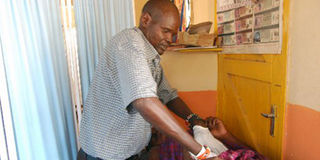One nurse, one dispensary and 9,000 patients

Julius Ekeru Lokiyoi, the nurse in-charge, and the only member of staff at the dispensary examines a patient. The dispensary serves more than 9,000 people. Photo/JOYCE MULAMA
Kang’atotha dispensary is secluded and surrounded by the shrubs of Kang’atotha Division in the arid and semi-arid Turkana.
It is a beehive of activity; patients sit on the benches waiting to be served, some groaning in pain. Others have come to collect medicine. Pregnant women sit at a corner; they have come for ante-natal care.
Mothers have brought their small and crying children for immunisation. An old man is seated on the floor with a deep cut, bleeding profusely. The would urgently needs dressing.
The scene is chaotic. Julius Ekeru Lokiyoi, the nurse in-charge, and the only medical staff at the facility, is evidently overwhelmed. He rushes to dress the old man’s cut, leaves it midway to attend to the pregnant women. Moments later he is immunising the children, 50 in number. That mission is hardly accomplished before resumes dressing the bleeding old man.
Immunising babies
Standing by the window are tired patients asking for drugs. They have been waiting over three hours. Among them is Regina Ekwara who, with her 11-month-old baby strapped to her back, had walked for more than 20 kilometres to get medicine.
Machine-like Lokiyoi attends to the people standing in the queue for a while, then resumes immunising the babies.
“I am everything in this hospital. I do the clerking, examination of patients, dispensing drugs, stitching cuts, ante-natal care and even delivery or babies,” he said, wiping strings of sweat off his face.
He soon leaves to assess the condition of a woman in labour screaming in a tiny makeshift ward within the dispensary.
Lokiyoi has been working like this for close to three years now. And at times he is forced to go to Lodwar District Hospital, 68 kilometres away, to collect drugs due to supplies delay by the Kenya Medical Supplies Agency. Whenever he is away, the dispensary is left unattended.
Drug shortage
“There is so much to do here. The demand for healthcare services is huge but facilities are scarce. I have been requesting for more nurses to help with the workload, all I have got are empty promises,” he noted. He would be comfortable with two or three more nurses at the dispensary, which serves a population of 9,000.
The chronic shortage of health personnel and drugs is replicated across most facilities in the region. Even Lodwar District Hospital, a referral institution, is not spared. The hospital, which serves the surrounding districts, has just four nurses, according Dr Gilchrist Lokoel, who is in charge.
Turkana, a 77,000 square kilometres region, is Kenya’s largest district. It has 34 health facilities and only 24 are operational. The rest have no staff, and are mostly run by community health workers, stated Dr Lokoel.
“The lack of medical staff contributes greatly to our inability to adequately respond to disease outbreaks and other emergencies,” he says. This has conspired to make preventable and treatable diseases more deadly than elsewhere in the country. Cholera claimed 34 children from August to December last year. More than 20 people have died this year from the same illness.
Challenges
With the absence of health personnel, awareness creation on issues such as immunisation is minimal. Immunisation coverage in the area is only 57 per cent, up from 47 per cent last year, according to Dr Lokoel. This makes a mockery of the government’s vaccine and immunisation plan which aspires to fully immunise at least 80 per cent of children in all districts by 2010.
The challenges are far-reaching, with unreliable refrigeration due to gas shortage, damage of vaccines is endemic. “We have to wait for funds from the government to buy gas, and the money delays all the time,” said Lokiyoi, adding: “In the process, vaccines get spoilt, and the few mothers who trek miles to bring their children for vaccination, often go back mission unaccomplished.”
Development organisations in the region state that investment in rural health infrastructure is key to achieving the Millennium Development Goals.
“Increased investment in health delivery, particularly in this area, is urgent to avoid unnecessary fatalities from preventable diseases,” noted Nicholas Wasunna, World Vision Kenya’s special adviser.
Recently the health sector received one billion shillings boost for hiring nurses, public health technicians and upgrading hospitals, purchase of ambulances, and motorcycles for community health workers. It is hoped that under-resourced health facilities such as Kang’atotha and Lodwar District Hospital will be given priority when the funds are distributed.
Turkana’s under-developed health system, complicated by the nomadic lifestyle in the predominantly pastoralist district, also makes it difficult for communities to access primary health care.
“These people move from place to place looking for pasture and water for their livestock. Interventions need to include mobile health services which should follow the people,” noted Innocent Sifuna, the district public health officer of Turkana Central.
“If we have to achieve universal health coverage, then we must take services to such populations rather than wait for them to seek the services,” he said.
Mobile health outreaches are underway, where in addition to providing primary healthcare, they are addressing malnutrition, rampant among children, pregnant, and lactating women.
Diseases
“We treat common diseases like malaria, cholera and diarrhoea, and teach the community how to prevent the same. These conditions are worsened by malnutrition since most of this area is semi-arid and people do not cultivate crops, and therefore do not have enough to eat,” said Margaret Nasilo, a nurse with World Vision’s Humanitarian Emergency Affairs programme for Turkana.
Those with severe malnutrition are admitted to the organisation’s malnutrition programme where they are given two-week rations of pre-mixed maize and soya blend as well as vegetable oil.




